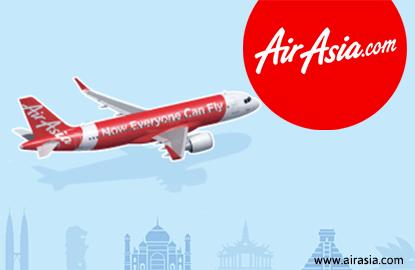
KUALA LUMPUR (Feb 23): AirAsia Bhd, which posted a 16% slide in fourth-quarter net profit, will grow its fleet size to over 200 aircraft this year as it continues to roll out new destinations in Asean, as well as boost its flight frequency on its "trunk" routes.
Trunk routes refer to high demand routes.
The budget airline will take delivery of 12 Airbus A320neos for its Malaysian operations this year.
"To increase the number of possible connections at our hub at klia2, we intend to increase to daily frequency up to 16 routes currently operated sub-daily, giving a boost to our Fly-Thru traffic," AirAsia group chief executive officer Tan Sri Tony Fernandes said in a statement today.
With all its four airlines in Malaysia, Thailand, Indonesia and the Philippines operationally profitable in 4QFY16, he said the airline will press forward with its expansion to combine the four operations under a single, listed Asean holding company.
"(As such,) we are urging Asean governments to relax ownership restrictions and consider Asean investors as equivalent to local investors," Fernandes added.
AirAsia saw its net profit drop 16% to RM465.32 million or 16.7 sen per share in the fourth quarter ended Dec 31, 2016 (4QFY16) from RM554.11 million or 19.9 sen per share a year ago, due to a 48% decline in aircraft operating lease income.
Quarterly revenue also fell 10.7% to RM1.94 billion from RM2.17 billion in 4QFY15.
In a filing with Bursa Malaysia today, AirAsia said passenger seat sales, however, increased in the current quarter under review, supported by a 5% growth in passenger volume while average fare was up 5% at RM186 from RM177 in 4QFY15.
Ancillary income per passenger, however, fell 4% year-on-year (y-o-y) to RM47 from RM49. The seat load factor was at 87% in 4QFY16, which was 2 percentage points higher than the same period last year.
For the full year FY16, however, the airline's net profit jumped 3.7 times to RM2.04 billion or 73.2 sen per share from RM541.19 million or 19.4 sen per share in FY15, while revenue grew 9.9% to RM6.92 billion from RM6.3 billion the previous year.
AirAsia said the increase in revenue was driven by a 9% growth in passenger volume in FY16, while capacity only increased by 1% y-o-y.
"Ancillary income per passenger increased by 2% to RM48 y-o-y and average fares were also up 6% to RM167 in FY16. The seat load factor was at 87% which was 6 percentage points higher than FY15," it added.
AirAsia's net debt amounted to RM8.8 billion as of Dec 31, 2016. Its gearing ratio fell to 1.3 times at the end of 4QFY16 from 2.29 times a year ago.
On its plans to monetise its leasing arm Asia Aviation Capital Ltd, Fernandes said it is at the due-diligence stage.
"We (also) continue to work towards an initial public offering for our crew training centre, AirAsia Aviation Centre of Excellence, and a dual listing for AirAsia Bhd in the Hong Kong or New York stock exchanges," he added.
Fernandes also pointed to the airline's expansion in India.
"We have plenty of growing to do (this year) even if we won’t start international flights until the second half of 2018. AirAsia India reports the highest aircraft utilisation rate among all short-haul airlines in the AirAsia Group, managing a 52% capacity increase in FY16, with the addition of just two aircraft from an initial fleet of six. Our focus remains on building our footprint and introducing our low fares to many more Indian cities," he said.
On AirAsia Japan Co Ltd, Fernandes said it is approaching a full launch soon. "Training flights as part of the regulator’s requirements took place in early-February and we are looking to open ticket sales from our Nagoya base soon. AirAsia Japan will end 2017 with a fleet of five aircraft,” he added.
On prospects, AirAsia said in Malaysia, the first quarter of 2017 is projected to achieve an average forecast load factor of 89% while for the remaining quarters of the year, it remains confident amid strong demand across most sectors coupled with a favorable fuel price environment despite continuous fare competition in the market. AirAsia’s Malaysian operations account for almost 60% of the airline’s total revenue.
"Barring any unforeseen circumstances, the directors remain positive for the prospects of the group in 2017," it said.
AirAsia shares closed down seven sen or 2.47% at RM2.76 today, bringing a market capitalisation of RM9.19 billion.